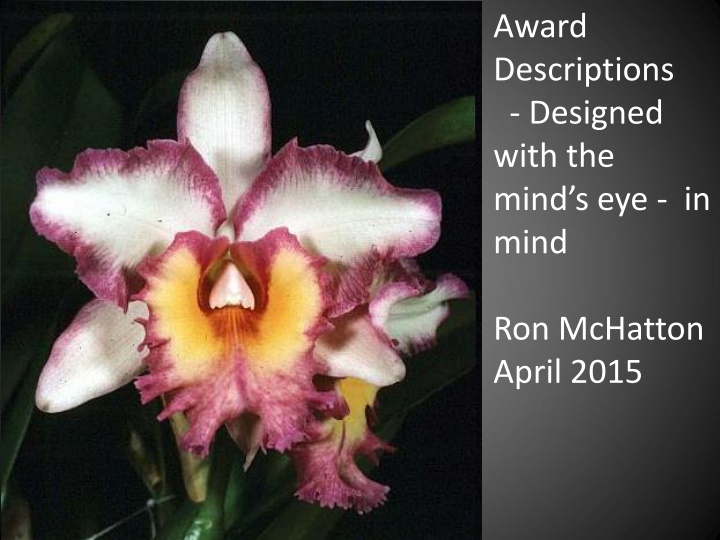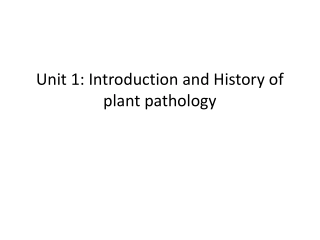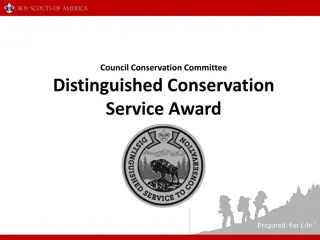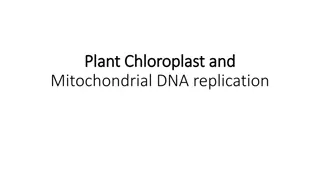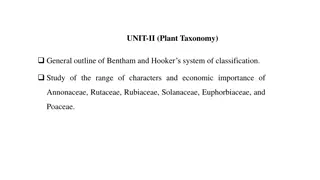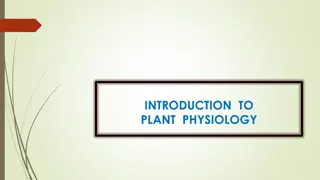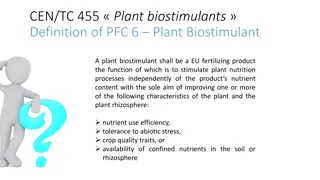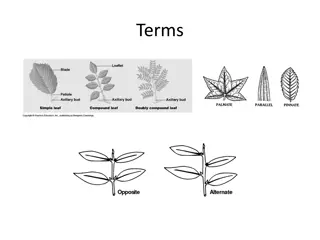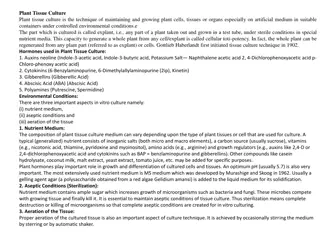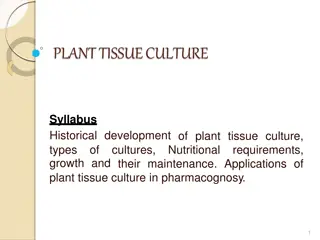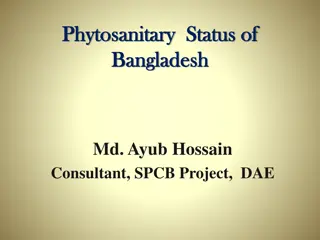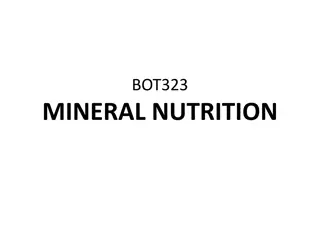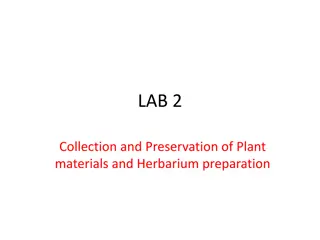Guidelines for Writing Plant Award Descriptions
Learn the essential rules for crafting precise and informative descriptions for plant awards. Discover the prescribed format, common errors to avoid, and the importance of providing detailed information in a structured manner.
Download Presentation

Please find below an Image/Link to download the presentation.
The content on the website is provided AS IS for your information and personal use only. It may not be sold, licensed, or shared on other websites without obtaining consent from the author.If you encounter any issues during the download, it is possible that the publisher has removed the file from their server.
You are allowed to download the files provided on this website for personal or commercial use, subject to the condition that they are used lawfully. All files are the property of their respective owners.
The content on the website is provided AS IS for your information and personal use only. It may not be sold, licensed, or shared on other websites without obtaining consent from the author.
E N D
Presentation Transcript
Award Descriptions - Designed with the mind s eye - in mind Ron McHatton April 2015
Why write descriptions at all when we have images? What if the image looks like this? Or this? Or this?
How many errors can you find in this description? Well grown plant has twelve pseudobulbs with three 25-cm. leaves each and one hundred and three flowers and fifty four buds on three branched, arching inflorescences up to 100cm long well held above foliage in a 10 inch pot. Flowers yellow, sepals have purplish stripping, petals basal one third with purple blotching; lip red; callus purple; column and 5 cm spur white; texture firm, substance matte. Commended for color combination which judges thought was striking. I think I find 31
ALL descriptions follow a prescribed format it is NOT the order in which the measurements are taken. 1. Flowers, buds, number of inflorescences 2. Description of plant and container if appropriate 3. Flower base color if appropriate 4. Dorsal sepal (or sepals if taken together) 5. Lateral sepals (or SYNSEPAL) if not included with dorsal sepal 6. Petals 7. Lip including crests, keels and spur 8. Column and anther cap (or staminode) 9. Substance 10. Texture 11. Ovary if noteworthy 12. Floral bracts if noteworthy 13. Rachis is noteworthy 14. Country of origin for botanical awards 15. Verification of identity 16. Any judges comments of note, i.e., .precluded higher score
Descriptions have one capital letter the first one the exception is if proper nouns are included like .cultivar dominated by Cattleya parent. and only one period at the very end. The description of plant or flower parts are separated by semi-colons sepals green; petals yellow; lip white Thoughts related to the description of a single segment are separated by commas sepals green, blotched maroon; sepals and petals white, petal apices flared magenta; Taking parts together is fine if it s appropriate sepals chartreuse, striped mahogany, synsepal less densely
First, ALL descriptions of awards involving plants with flowers start with the number of flowers, buds and inflorescences. Unopened or immature inflorescences are included in the count. Err on the side of more information than less i.e., Sixty-four flowers on one branched inflorescence, 53 buds on a second inflorescence and 3 buds on an additional immature inflorescence is of much more value to subsequent judges than Sixty-four flowers and 56 buds on 3 inflorescences The first case lets the reader know that 64 on an inflorescence is possible. The latter is 40 per infl.
Use of descriptive qualifiers In my opinion not used enough This is your opportunity to say why you awarded something but make sure the words match the numbers Three remarkable, flat flowers .. Five brilliantly colored, eye-catching, flat flowers on a sharply erect, impressive inflorescence Four striking, dramatic flowers Sepals and petal electric green
Form modifiers almost never enough flowers full, cupped, cernuate (nodding), campanulate (bell-like), flat, open or stellate, etc. petals porrect, reflexed, inrolled, fused lip at 90 degrees to floral plane margins surfaces smooth, crisped, undulate, feathered, fimbriate or fringed, ruffled, dentate, warted smooth, papilose, scurfid (scaly), pubescent, hairy
A word (or two or three) about hairs Canescent Pubescent Ciliate Sericeous Floccose warts
These petals are not goffered they are undulate or wavy Old-style postage stamps in sheets have goffered edges Goffered edge face-on Goffering viewed edge- on
Develop the habit to describe flowers consistently if you describe the sepals and petals in layers beginning with base color and work out from the colum and add layers, i.e., Sepal and petal base color white overlaid soft pink, proximally peppered darker pink, medially spotted rose-pink, apically flared dark rose- pink then follow the same order for the lip lip white, distally overlaid lavender veined purple Means something quite different from lip white veined purple, distally overlaid lavender or lip white, proximally veined purple, distally overlaid lavender What s that in the road, a head? Or What s that in the road ahead?
Avoid descriptors that are ambiguous without a picture. Which is correct? petal upper halves coarsely spotted brown-maroon, lower halves less spotted petal proximal superior halves coarsely spotted maroon, inferior halves less spotted
Distal apex Basal Medial Proximal Central Superior Inferior
Substance: This is what you feel firm, heavy, thin, tissue-paper, rigid what does average mean? Texture: This is what you see crystalline, satiny, waxy, matte, scurfy Describe the majority first, then the exception texture crystalline, lip waxy.
Numbers The first number at the beginning of the description is written as such Fifty-four flowers vs. 54 Flowers other numbers in the text numbers less than 11 are written out - eleven 11 and higher are written as numbers the exception to the rule is measurements all measurements are written as numbers 7-cm or 13cm not seven-cm measurements expressed as adjectives are hyphenated 103-cm inflorescence 5.7-cm spur if the measurement follows the noun, there is no hyphen on six inflorescences to 103cm long on three inflorescences of 110cm average length
Colors One of the single biggest sources of confusion in descriptions two colors, one of which modifies the other are hyphenated yellow-green, red-brown fruit and vegetable colors are acceptable and are not hyphenated lemon yellow, lime green, apple green, grass green Rose ANYTHING is always hyphenated since ROSE is a color that modifies the other Raspberry is NOT a color, it should be raspberry pink or raspberry red, etc. The debate still continues whether cream is a color if not it should be cream-color Do not use ish as in greenish-yellow if you mean that use chartreuse or green-yellow Use of y is acceptable and is not hypenated creamy yellow Be very careful of ambiguous combinations rust red do you mean rust-colored or a color that is rusty red?
This is NOT a green flower To say flowers green; lip yellow is incorrect It should be sepals and petals green; lip yellow, In a similar fashion, the flower to the right shouldn t be described as flowers red; lip yellow . But sepals and petals red; lip yellow, distally splashed red, side margins darker yellow;
These flowers arent concolor white Flower base color clear, uniform white; lip side lobes proximally bright yellow;
This flower is not pristine white. Pristine white implies pure, unblemished. Sparkling, bright, clear are all better descriptors.
Apical flares vs. distal flares
Well grown plant has twelve pseudobulbs with three 25-cm. leaves each and one hundred and three flowers and fifty four buds on three branched, arching inflorescences up to 100cm long well held above foliage in a 10 inch pot. Flowers yellow, sepals have purplish stripping, petals basal one third with purple blotching; lip red; callus purple; column and 5 cm spur white; texture firm, substance matte. Commended for color combination which judges thought was striking.
One hundred three flowers and 54 buds well-held above foliage on three branched, arched inflorescences to 100cm long produced on a well-grown, 12-pseudobulb plant grown in a 25-cm pot; leaves, three per pseudobulb, 25cm long; sepals and petals yellow, sepals striped purple, petal proximal one-third blotched purple; lip red, callus purple, 5-cm spur white; column white; substance firm; texture matte; commended for striking color combination.
